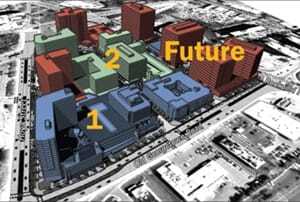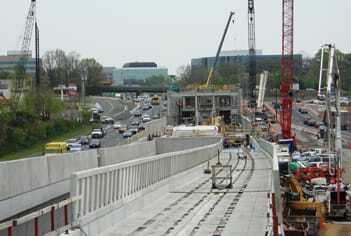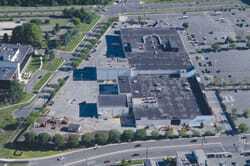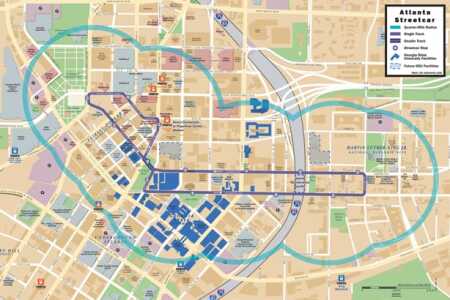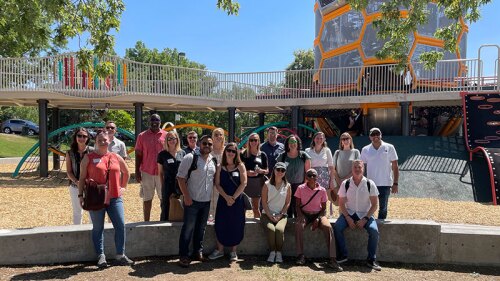Across the country, hopes and ambitions for transit remain high, despite a scarcity of public resources to fund it. As local governments struggle, private sector landowners are offering solutions. Over the past year, Urban Land’s Business on Board series has explored the shifting role of the private sector in advancing—advocating, planning, providing, and helping pay for—transit. In this article, which concludes the series, we examine the growing use of special property tax assessments for transit.
Special assessments for transit can be used to channel revenues from property tax rate increases to fund transit construction, operations, or related infrastructure improvements. Increased tax rates typically apply only in defined districts that will benefit from the transit investment.
The tool is flexible: it can be applied to commercial or industrial property only, or it can include residential land uses. Tax rates can be constant or can vary over time. The districts are being set up in both suburban and downtown contexts and are funding a wide variety of transit types, from heavy rail to streetcars to bus rapid transit (BRT).
Special assessment districts for transit, like tax increment financing (TIF), are a type of value-capture financing. Both tap into the real estate value created by infrastructure investments. With TIF, however, governments hold tax rates constant and use expected bumps in tax revenues from increased property values to finance the debt for the project.
Special assessment districts are more direct and less risky. By increasing the property tax rate, they capture a guaranteed portion of current property value in addition to a portion of future increases in property value. TIF usually requires a designation of blight, but special assessment districts do not; this makes special assessment districts an important funding tool for economically healthy communities looking to invest in their future.
Employed extensively in Portland, Oregon, to finance streetcar lines in the 1990s, a special assessment district is established through a process that varies across the country. Although government involvement is necessary, private sector businesses increasingly are stepping in. Recognizing the role that transit can play in supporting growth, property owners and developers are working with local governments to create special assessment districts for transit and transit-related investments. Critical federal transit funding can hinge on these local contributions.
In fast-growing northern Virginia, for example, special assessment districts will provide up to $1 billion in funding for the Silver Line, a $6 billion, 23-mile (37 km) extension of the region’s Metrorail system being built in two phases. Phase I of the project will bring the Silver Line through employment hub Tysons Corner—part of an effort to transform the sprawling retail and office complex into a high-density, walkable neighborhood.
Because transit will be key to the reinvention of the area, property owners—taking advantage of a Virginia law that allows property owners to petition to tax themselves to pay for transportation improvements—agreed in 2004 to the establishment of an assessment district to fund the local share of the $2.6 billion price tag for Phase I.
Timothy J. Steffan, senior vice president at Macerich, described why his firm supported the assessment. “You didn’t get any upzoning until the delivery of Metro was assured. And you could only be assured of bringing Metro if you had a funding source.” Of the tax, he said, “You knew what you were getting for it, and you knew what it would do for Tysons. You knew that increases in density were going to be allowed, and as a result you could value the future development rights.”
The district, created with the approval of 64 percent of local property owners, will generate up to $400 million from a tax of 22 cents per $100 of assessed value on commercial and industrial properties near the corridor. Additional funding is being drawn from federal transit grants, toll road revenues, and other sources.
| A phasing plan for Federal Realty’s Pike & Rose project |
Phase I of the rail line is under construction, with operations expected by 2013. The funding path forward for Phase II, which will connect the rail system to Dulles International Airport in Loudoun and Fairfax counties and points beyond, has only recently been determined. Local funding for Phase II is being generated by a taxing district approved in 2009, with charges on commercial and industrial properties near the transit corridor escalating from 5 cents per $100 in value in 2010 to 20 cents per $100 in 2013, for a total contribution of up to $330 million. But Phase II needed more local funding, which was up to rapidly urbanizing Loudoun County to provide.
In a squeaker 5–4 vote in July, Loudoun County’s Board of Supervisors approved $270 million in capital funding, and $10 million per year in funding for operations, generated from a special tax district. The district encompasses commercial property and undeveloped land around the Metro station locations; it excludes most existing residential property, although new residential buildings will be taxed. Loudoun County’s vote means that Phase II of the extension project can proceed.
The structure of the funding through a special assessment district was key. “This essentially is something that has allowed me to lean to the direction of supporting the project,” said Kenneth D. Reid, a once-skeptical Republican member of the Loudoun County Board of Supervisors, after the July vote. According to the Washington Post, Reid had not wanted to rely on general revenues or a countywide tax for the project. “This is a huge investment in Loudoun’s future,” said Tony Howard, the president of Loudoun County’s Chamber of Commerce, which had thrown its support behind the project. “The chamber is absolutely elated,” Howard was quoted in the Post as saying.
On the Maryland side of the Washington metropolitan area, six major real estate players in north Bethesda are working together to help transform a 430-acre (174 ha) area bisected by traffic-laden Rockville Pike into a place more friendly to pedestrians, transit, and development. Despite being served by heavy rail, the area is dominated by strip retail and parking lots, and development proposals once stumbled up against concerns about traffic congestion and road capacity.
| Construction of Phase I of the Silver Line is underway, with operations |
In 2008, real estate companies, including the JBG Companies, Federal Realty Investment Trust, and Lerner Enterprises, formed the White Flint Partnership to unlock the development potential of the area in part by planning and funding a comprehensive set of transportation improvements. “The partnership allowed companies who would normally be competitive to jointly fund an economic-benefit study, a taxing-mechanism study, and community outreach,” said Evan Goldman, vice president at Federal Realty Investment Trust.
The companies agreed to add to the street grid and improve other infrastructure within their property boundaries, investments that will cost about $280 million. They also worked with Montgomery County to create a special taxing district that will spin off revenues to fund a comprehensive set of investments in sidewalks, bike facilities, and other improvements along Rockville Pike and two other major streets. Initiated in July 2011, the ad valorem tax of 10 cents on $100 of assessed property value will raise $169 million before it expires. “We are increasing the value of all of our properties by working collectively to address transportation challenges,” says Greg Trimmer, principal at JBG.
The tax applies to commercial property and new rental apartment buildings, with existing residential rental buildings exempted. The Montgomery County Planning Board proposed the taxing district, and it was approved by the county council and county executive. The county is contributing $152 million in transportation upgrades in the area and is likely to see $5 billion to $6 billion in additional property tax revenue over the next 30 years.
The White Flint partners are helping fund improvements that will make Rockville Pike a more attractive and accessible place for transit, and are providing a funding model for the next push—creation of an ambitious, 160-mile (260 km) countywide BRT system. The system, which supporters hope will be operational by 2016, would complement the heavy-rail system and provide more fine-grained transit connectivity along commercial corridors like Rockville Pike. It is likely to cost about $1.8 billion to build and $180 million per year to operate and maintain.
A Montgomery County task force is focusing on the creation of special property tax districts to fund the BRT network. A range of tax assessment options and financing alternatives is on the table, from taxing only properties within a half mile (0.8 km) of the transit route to taxing all property in the county. Revenue from these levies will generate the local share of debt-service payment for the system’s capital costs and help offset operating losses.
| MidPike Plaza is getting a major makeover as |
Washington’s strong real estate market makes increased property tax assessments more palatable than they might be elsewhere, but the region is not the only place using special tax assessments for transit. Property assessments are helping fund new streetcar lines in Tampa, Seattle, San Francisco, and Kansas City, Missouri, and the success of a push for streetcars in Los Angeles will depend on support from local property owners.
Construction costs for Atlanta’s new downtown streetcar line are being funded by commercial property tax assessments. The $83 million streetcar project, which is scheduled for completion in 2013, will include 2.6 miles (4.2 km) of track and 12 stations, and is expected to solve transit connectivity problems and accelerate the economic revitalization of downtown.
The Atlanta Downtown Improvement District is setting aside for the streetcar a portion of its revenue generated from an annual assessment of 5 cents per $1,000 of assessed commercial value on 200 city blocks. In 2010, the district’s board, which has long championed the streetcar project, approved an allocation for transit from the district’s ongoing funding of up to $20 million over 20 years, split between construction and annual operating contributions.
Downtown real estate leaders, including Craig Jones, executive vice president at Cousins Properties, see the streetcar as critical to the future of the city. “For our high-rise properties to work, you really need transit,” Jones said in an interview. “And we feel that the streetcar will result in more development and raise the values of our existing property.”
Jones noted that the support for transit reflects the improvement district’s priorities. “This was the first time that we’ve allocated money to transit. Before, the district funded capital projects like streetscape improvements, and we’ll still have money for items like that,” he said. “But we know that transit is important to the region being able to grow, and we understand the value of infrastructure. It’s enlightened self-interest.”
The property assessments are a key component of the funding package for the transit line. An initial bid for federal funding under the federal TIGER (Transportation Investment Generating Economic Recovery) grant program failed, but in 2010 a reconfigured application, with a scaled-down funding request and additional local contributions, won the project nearly $48 million in TIGER II money. With funding from the city and other sources covering the remaining capital costs, efforts are now focused on determining how the system will be operated.
The Atlanta Streetcar, with 2.6 track miles (4.2 km) and 12 stops, will help solve downtown circulation issues by adding transit connectivity. Downtown real estate companies have been key proponents of the project. |
Like any funding source, however, property tax assessments for transit pose challenges. Each effort must be tailored to the specific local political and legal context, and special assessment districts are not authorized in every municipality. Private sector support for increased property assessments is usually procedurally and politically necessary, and this support often hinges on zoning changes that allow additional density, which can be controversial. And answers to key questions—including what tax rates to use, what kind of properties to include, and where the benefit district boundary should be—are not always straightforward.
But in the absence of large new federal infusions for transit, and in the face of increasingly tight local government purse strings, expect special assessment districts to become another common tool in the transit-funding toolbox. The flexibility of special assessment districts—in scale, affected property types, transit type, assessment level, and application to both urban and suburban settings—makes them an attractive option. And because they draw a direct line from transit investment to the enhanced accessibility and connectivity that new transit brings, and to increased property values, their appeal is likely to endure.
This article is part of the “Business on Board,” series investigating the business community’s role in advancing transit. To be added to the infrastructure mailing list, e-mail [email protected] .
To read other articles in this series, see:
Seattle and Suburbs Find Innovative Compromise to Save TransitUtah Business Embrace Light Rail
Regional Transit: Regrouping in the Tampa Bay Area
Healthline Drives Growth in Cleveland
Hidden Transit: How Employers and Property Managers are Taking Transit into their Own Hands

